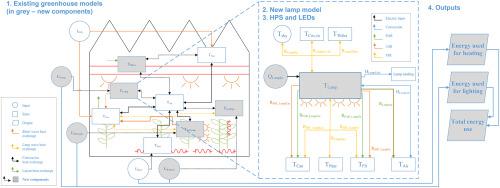当前位置:
X-MOL 学术
›
Biosyst. Eng.
›
论文详情
Our official English website, www.x-mol.net, welcomes your
feedback! (Note: you will need to create a separate account there.)
GreenLight – An open source model for greenhouses with supplemental lighting: Evaluation of heat requirements under LED and HPS lamps
Biosystems Engineering ( IF 4.4 ) Pub Date : 2020-06-01 , DOI: 10.1016/j.biosystemseng.2020.03.010 David Katzin , Simon van Mourik , Frank Kempkes , Eldert J. van Henten
Biosystems Engineering ( IF 4.4 ) Pub Date : 2020-06-01 , DOI: 10.1016/j.biosystemseng.2020.03.010 David Katzin , Simon van Mourik , Frank Kempkes , Eldert J. van Henten

|
Greenhouse models are important tools for the analysis and design of greenhouse systems and for offering decision support to growers. While many models are available, relatively few include the influence of supplementary lighting on the greenhouse climate and crop. This study presents GreenLight, a model for greenhouses with supplemental lighting. GreenLight extends state of the art models by describing the qualitative difference between the common lighting system of high-pressure sodium (HPS) lamps, and the newest technology for horticultural lighting - the light-emitting diodes (LEDs). LEDs differ from HPS lamps in that they operate at lower temperatures, emit mostly convective heat and relatively little radiative heat, and can be more efficient in converting electricity to photosynthetically active radiation (PAR). These differences can have major implications on the greenhouse climate and operation, and on the amount of heat that must be supplied from the greenhouse heating system. Model predictions have been evaluated against data collected in greenhouse compartments equipped with HPS and LED lamps. The model predicted the greenhouse's heating needs with an error of 8–51 W m−2, representing 1–12% of the measured values; the RMSE for indoor temperature was 1.74–2.04 °C; and the RMSE for relative humidity was 5.52–8.5%. The model is freely available as open source MATLAB software at https://github.com/davkat1/GreenLight . It is hoped that it may be further evaluated and used by researchers worldwide to analyse the influence of the most recent lighting technologies on greenhouse climate control.
中文翻译:

GreenLight – 带有补充照明的温室的开源模型:评估 LED 和 HPS 灯下的热量要求
温室模型是分析和设计温室系统以及为种植者提供决策支持的重要工具。虽然有许多模型可用,但相对较少包括补充照明对温室气候和作物的影响。这项研究展示了 GreenLight,这是一种带有补充照明的温室模型。GreenLight 通过描述高压钠灯 (HPS) 灯的常见照明系统与园艺照明的最新技术 - 发光二极管 (LED) 之间的质量差异,扩展了最先进的模型。LED 与 HPS 灯的不同之处在于它们在较低温度下工作,主要发出对流热和相对较少的辐射热,并且可以更有效地将电能转换为光合有效辐射 (PAR)。这些差异可能对温室气候和运行以及温室供暖系统必须提供的热量产生重大影响。模型预测已根据在配备 HPS 和 LED 灯的温室隔间中收集的数据进行评估。该模型预测温室的供暖需求,误差为 8-51 W m-2,占测量值的 1-12%;室内温度的RMSE为1.74-2.04°C;相对湿度的 RMSE 为 5.52-8.5%。该模型可作为开源 MATLAB 软件在 https://github.com/davkat1/GreenLight 上免费获得。希望它可以被世界各地的研究人员进一步评估和使用,以分析最新的照明技术对温室气候控制的影响。以及必须从温室供暖系统提供的热量。模型预测已根据在配备 HPS 和 LED 灯的温室隔间中收集的数据进行评估。该模型预测温室的供暖需求,误差为 8-51 W m-2,占测量值的 1-12%;室内温度的RMSE为1.74-2.04°C;相对湿度的 RMSE 为 5.52-8.5%。该模型可作为开源 MATLAB 软件在 https://github.com/davkat1/GreenLight 上免费获得。希望它可以被世界各地的研究人员进一步评估和使用,以分析最新的照明技术对温室气候控制的影响。以及必须从温室供暖系统提供的热量。模型预测已根据在配备 HPS 和 LED 灯的温室隔间中收集的数据进行评估。该模型预测温室的供暖需求,误差为 8-51 W m-2,占测量值的 1-12%;室内温度的RMSE为1.74-2.04°C;相对湿度的 RMSE 为 5.52-8.5%。该模型可作为开源 MATLAB 软件在 https://github.com/davkat1/GreenLight 上免费获得。希望它可以被世界各地的研究人员进一步评估和使用,以分析最新的照明技术对温室气候控制的影响。模型预测已根据在配备 HPS 和 LED 灯的温室隔间中收集的数据进行评估。该模型预测温室的供暖需求,误差为 8-51 W m-2,占测量值的 1-12%;室内温度的RMSE为1.74-2.04°C;相对湿度的 RMSE 为 5.52-8.5%。该模型可作为开源 MATLAB 软件在 https://github.com/davkat1/GreenLight 上免费获得。希望它可以被世界各地的研究人员进一步评估和使用,以分析最新的照明技术对温室气候控制的影响。模型预测已根据在配备 HPS 和 LED 灯的温室隔间中收集的数据进行评估。该模型预测温室的供暖需求,误差为 8-51 W m-2,占测量值的 1-12%;室内温度的RMSE为1.74-2.04°C;相对湿度的 RMSE 为 5.52-8.5%。该模型可作为开源 MATLAB 软件在 https://github.com/davkat1/GreenLight 上免费获得。希望它可以被世界各地的研究人员进一步评估和使用,以分析最新的照明技术对温室气候控制的影响。相对湿度的 RMSE 为 5.52-8.5%。该模型可作为开源 MATLAB 软件在 https://github.com/davkat1/GreenLight 上免费获得。希望它可以被世界各地的研究人员进一步评估和使用,以分析最新的照明技术对温室气候控制的影响。相对湿度的 RMSE 为 5.52-8.5%。该模型可作为开源 MATLAB 软件在 https://github.com/davkat1/GreenLight 上免费获得。希望它可以被世界各地的研究人员进一步评估和使用,以分析最新的照明技术对温室气候控制的影响。
更新日期:2020-06-01
中文翻译:

GreenLight – 带有补充照明的温室的开源模型:评估 LED 和 HPS 灯下的热量要求
温室模型是分析和设计温室系统以及为种植者提供决策支持的重要工具。虽然有许多模型可用,但相对较少包括补充照明对温室气候和作物的影响。这项研究展示了 GreenLight,这是一种带有补充照明的温室模型。GreenLight 通过描述高压钠灯 (HPS) 灯的常见照明系统与园艺照明的最新技术 - 发光二极管 (LED) 之间的质量差异,扩展了最先进的模型。LED 与 HPS 灯的不同之处在于它们在较低温度下工作,主要发出对流热和相对较少的辐射热,并且可以更有效地将电能转换为光合有效辐射 (PAR)。这些差异可能对温室气候和运行以及温室供暖系统必须提供的热量产生重大影响。模型预测已根据在配备 HPS 和 LED 灯的温室隔间中收集的数据进行评估。该模型预测温室的供暖需求,误差为 8-51 W m-2,占测量值的 1-12%;室内温度的RMSE为1.74-2.04°C;相对湿度的 RMSE 为 5.52-8.5%。该模型可作为开源 MATLAB 软件在 https://github.com/davkat1/GreenLight 上免费获得。希望它可以被世界各地的研究人员进一步评估和使用,以分析最新的照明技术对温室气候控制的影响。以及必须从温室供暖系统提供的热量。模型预测已根据在配备 HPS 和 LED 灯的温室隔间中收集的数据进行评估。该模型预测温室的供暖需求,误差为 8-51 W m-2,占测量值的 1-12%;室内温度的RMSE为1.74-2.04°C;相对湿度的 RMSE 为 5.52-8.5%。该模型可作为开源 MATLAB 软件在 https://github.com/davkat1/GreenLight 上免费获得。希望它可以被世界各地的研究人员进一步评估和使用,以分析最新的照明技术对温室气候控制的影响。以及必须从温室供暖系统提供的热量。模型预测已根据在配备 HPS 和 LED 灯的温室隔间中收集的数据进行评估。该模型预测温室的供暖需求,误差为 8-51 W m-2,占测量值的 1-12%;室内温度的RMSE为1.74-2.04°C;相对湿度的 RMSE 为 5.52-8.5%。该模型可作为开源 MATLAB 软件在 https://github.com/davkat1/GreenLight 上免费获得。希望它可以被世界各地的研究人员进一步评估和使用,以分析最新的照明技术对温室气候控制的影响。模型预测已根据在配备 HPS 和 LED 灯的温室隔间中收集的数据进行评估。该模型预测温室的供暖需求,误差为 8-51 W m-2,占测量值的 1-12%;室内温度的RMSE为1.74-2.04°C;相对湿度的 RMSE 为 5.52-8.5%。该模型可作为开源 MATLAB 软件在 https://github.com/davkat1/GreenLight 上免费获得。希望它可以被世界各地的研究人员进一步评估和使用,以分析最新的照明技术对温室气候控制的影响。模型预测已根据在配备 HPS 和 LED 灯的温室隔间中收集的数据进行评估。该模型预测温室的供暖需求,误差为 8-51 W m-2,占测量值的 1-12%;室内温度的RMSE为1.74-2.04°C;相对湿度的 RMSE 为 5.52-8.5%。该模型可作为开源 MATLAB 软件在 https://github.com/davkat1/GreenLight 上免费获得。希望它可以被世界各地的研究人员进一步评估和使用,以分析最新的照明技术对温室气候控制的影响。相对湿度的 RMSE 为 5.52-8.5%。该模型可作为开源 MATLAB 软件在 https://github.com/davkat1/GreenLight 上免费获得。希望它可以被世界各地的研究人员进一步评估和使用,以分析最新的照明技术对温室气候控制的影响。相对湿度的 RMSE 为 5.52-8.5%。该模型可作为开源 MATLAB 软件在 https://github.com/davkat1/GreenLight 上免费获得。希望它可以被世界各地的研究人员进一步评估和使用,以分析最新的照明技术对温室气候控制的影响。











































 京公网安备 11010802027423号
京公网安备 11010802027423号